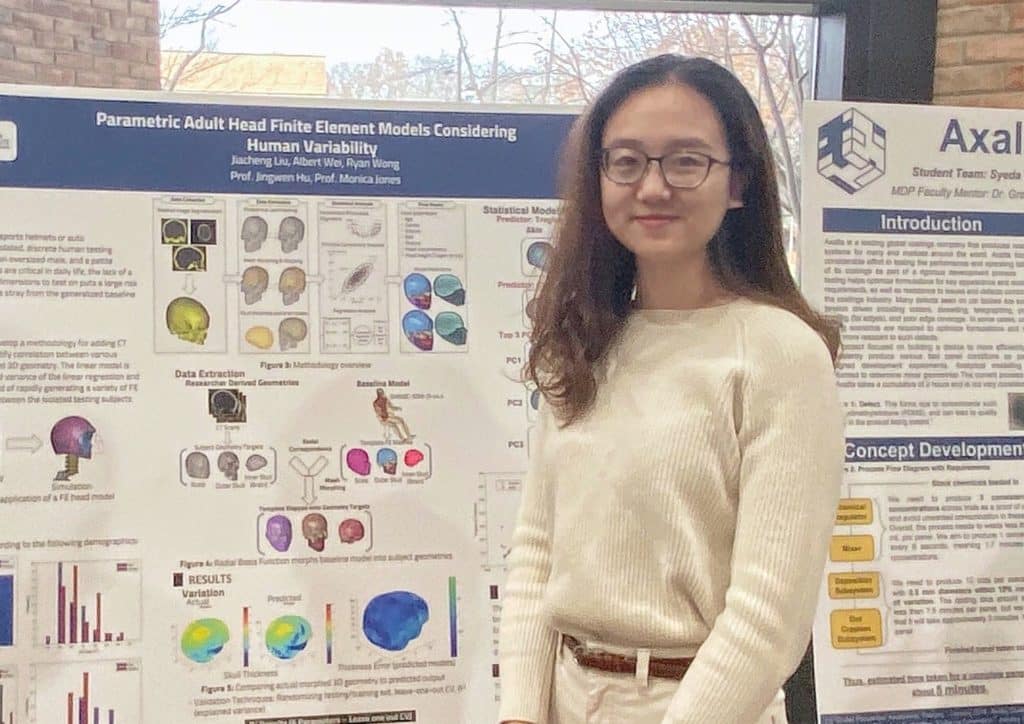ISD students engage in groundbreaking mobility safety equity research through model-based system designing approaches
Integrative Systems + Design research on model-based system designing envisions an equity-centered automotive safety. The continuing evolution of automotive technology aims to deliver even greater safety benefits than earlier technologies. One day, automated driving systems, which some refer to as automated vehicles, may be able to handle the whole task of driving when we don’t want to or can’t do it ourselves.
Dr. Jingwen Hu is an ISD faculty expert in modeling research. He is the Associate Director and a Research Professor of University of Michigan Transportation Research Institute (UMTRI). Dr. Hu, together with ISD students Sailesh Ganesan, Jiacheng Liu, Muwei Teng, Yushi Wang, and Venu Vinod Sripada, researched adaptive safety designs of human mobility systems through model-based crash simulations.
Effects of Crashes

One study, Adaptive Designs for Human Mobility Safety, concluded a major overhaul of federal safety requirements is needed to mandate that automotive makers take into account occupant diversity when testing the effects of crashes.
Dr. Hu and the ISD students have led a recently completed computer-simulated crash vehicle research studies.
During the study, hundreds of human body models with a wide range of sizes and shapes were created by morphing a baseline midsized male human model, and were set up for crash simulations. Based on the results, researchers concluded the UMTRI morphed models can simulate human body impact responses reasonably well and showed huge variations in their impact responses. More importantly, the capability of creating diverse human body models will serve as a major enabler for future vehicle safety designs accounting for the variations in occupant size and shape.
“Future work on this project could include further improving the mesh morphing technology,” Dr. Hu said. “improving the morphed human body models through subject-specific model validations, and applying those models into adaptive safety designs that can address safety equity issues among our diverse population.”
Crashing the Crash Dummy Bias

Crash-test dummies used for generations to develop airbags, seat belts, and other breakthrough automobile-safety systems are limited because they are mostly based on protecting the bodies of mid-sized males.
Not just any males, mind you.
We’re talking 1960s males that may weigh up to 50 pounds less than their modern counterparts. When the crash test dummy was first standardized in the mid-1970s, its weight and height were based on an average-size man. It was designed that way at the time because men were the primary vehicle drivers and at most risk for the greatest injury and greatest fatality.
Crash-test dummies today fail to take into consideration different sexes, ages, and body sizes and shapes that represent a diverse population of occupants, but should always reflect the real-life physical features of the humans they’re designed to mimic, Dr. Hu said.
“For years, when we addressed safety issues, especially motor vehicle issues, we used crash dummies presenting a mid-sized male, a small female, and a large male, but the focus was mostly on mid-sized males,” Dr. Hu said. “The world has changed. Today, there are more female drivers than male drivers. The population has gotten older, and weighs more. It makes no sense to design vehicles without taking into consideration different body sizes, shapes, and ages to represent a diverse population. The industry has to change to adapt to the changes occurring in the real world.”
Eliminating Gender Bias
Both medical science and actual crash data from the National Highway Traffic Safety Administration indicate automobile accidents really injure women differently from men.
The generally smaller skeletal structure of women, and the difference in body shape, mean they tend to sit closer to the steering wheel and have differences in muscle and bone mass that can make them more susceptible than men to serious injuries. A recent national study shows a female driver today is 73% more likely than a male driver to suffer serious injury in a car accident, and is 17% more likely to die.
“What we learned is we can develop computational tools to represent a diverse population, including females,” Dr. Hu said. “We can conduct thousands of crash simulations in the computer using hundreds of human body models. Such efforts helped us better understand why women tend to have higher injury risks than men in crashes, and better position us to design safer cars for both males and females at the same time.”
Studying Pedestrian Crashes

Dr. Hu and ISD students also completed a second research study, A Method to Reconstruct Pedestrian Motor Vehicle Crashes to Estimate the Effectiveness of Pedestrian AEB. The study, funded by Ford Motor Co., reconstructed 25 pedestrian crash scenarios with varied vehicle impact location and speed, as well as pedestrian size, impact orientation, and speed.
“In the last decade, Pedestrian Automatic Emergency Braking has been introduced in production vehicles in the U.S. to tackle this problem,” Dr. Hu said. “Their field effectiveness is not well understood. Computational reconstruction of recent pedestrian injury cases involving various vehicle types and pedestrian sizes is not common, but useful in predicting the vehicle speed and impact location of these crashes. By validating the reconstruction method, these models can be used to check if the Ped AEB feature is truly useful.”
Exploring Brain Injury

Dr. Hu’s third recently completed study, Brain Impact Responses Considering Morphological Variations Among Youth and Young Adults, looked at significant morphological and biomechanical variations that exist in the human skull and brain.
The study evaluated tissue-level impact responses on 101 adult brain Finite Element models, accounting for the morphological variations. Impact strain responses show a positive relationship with brain volume and shape, indicating the influence of morphological head variations on an individual’s brian injury risk, which was rarely evaluated previously.
“The regression model built based on the strain among 101 subject-specific and the brain geometric characteristics shows the potential to predict the brian injury risk based on the individual’s morphological features,” Dr. Hu said. “Different maximum strain concentrated areas provide useful information to explore brain injury mechanisms in the future.”
Improving Vehicle Safety

Simulating vehicle crashes with human models on computers is as good or better than using physical crash dummies in live demonstrations, Dr. Hu said.
